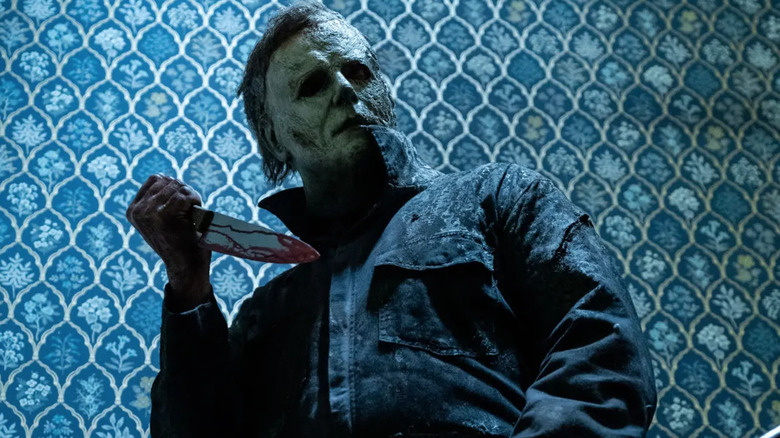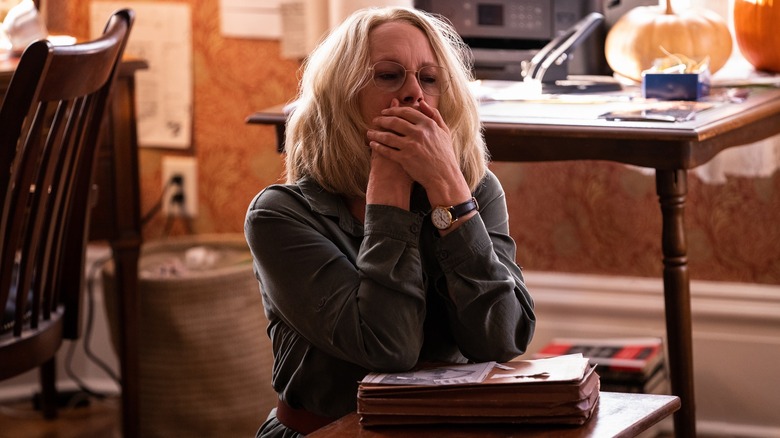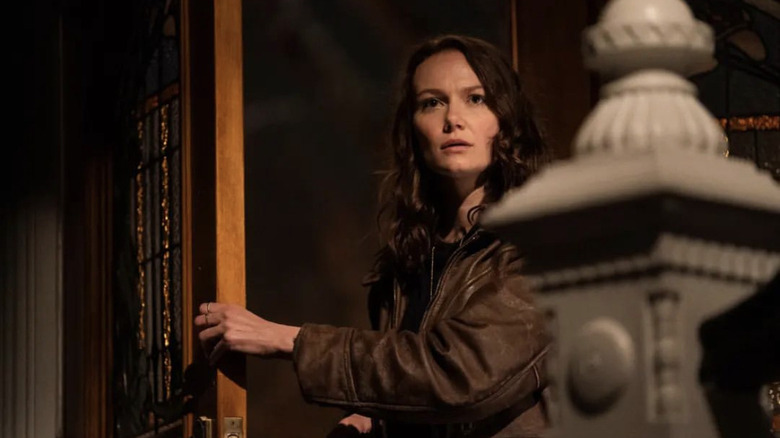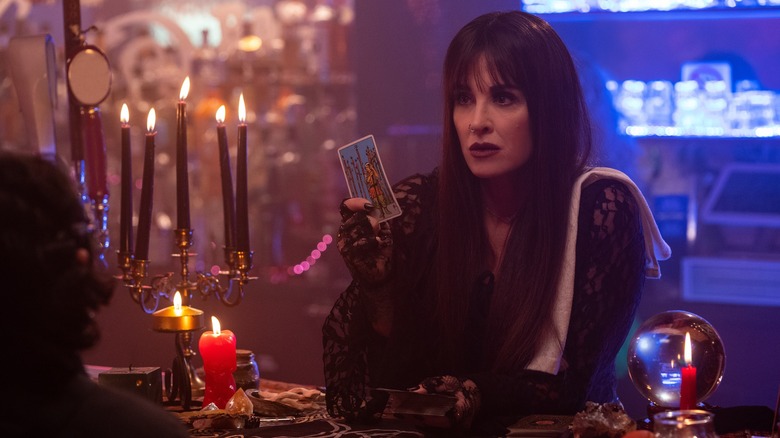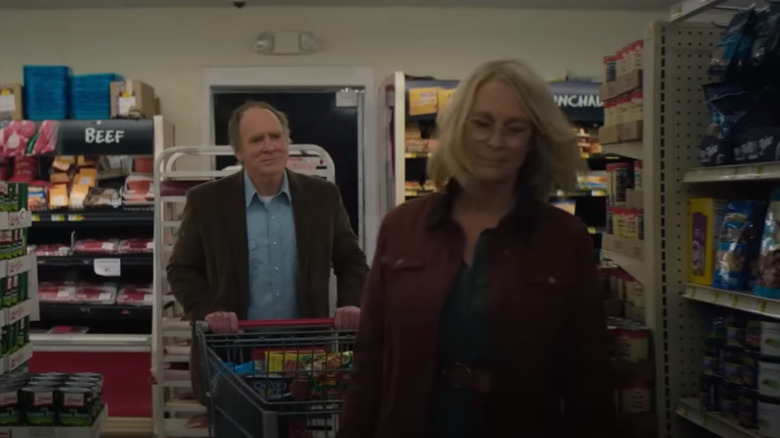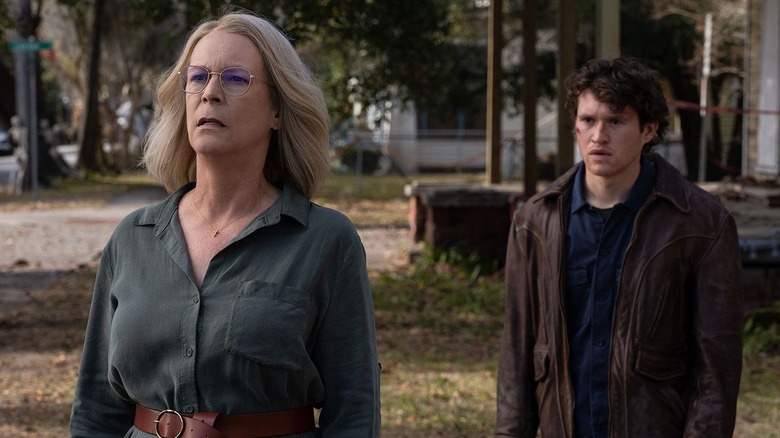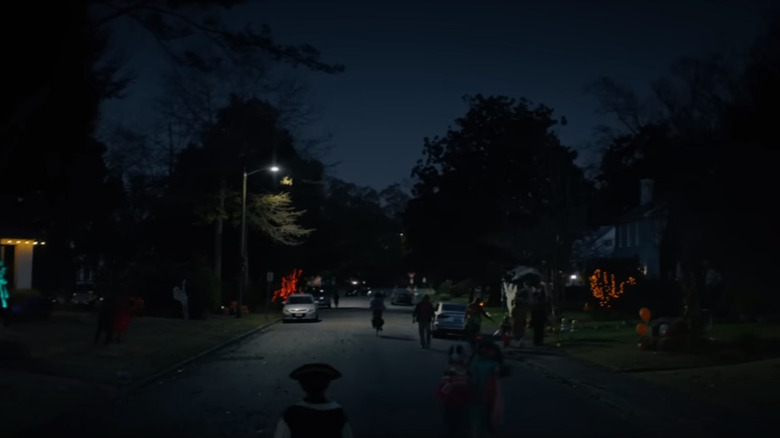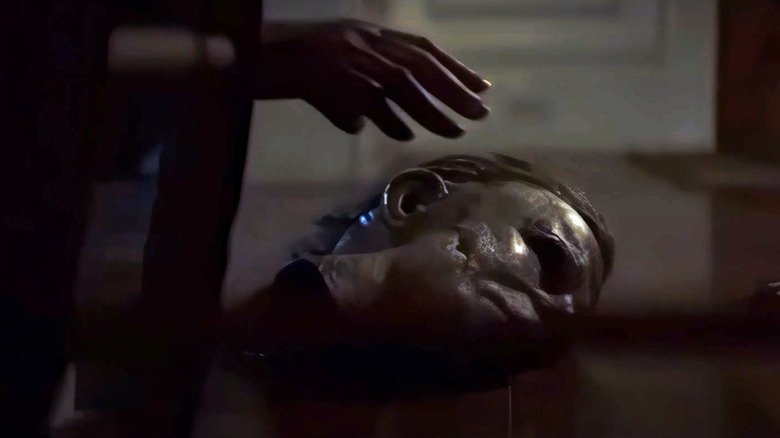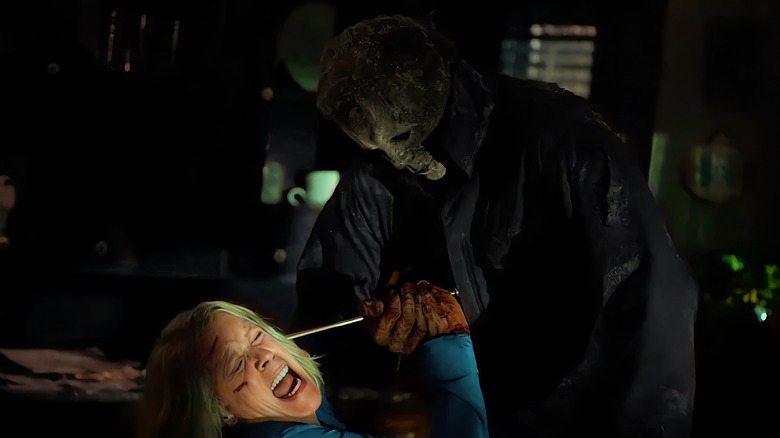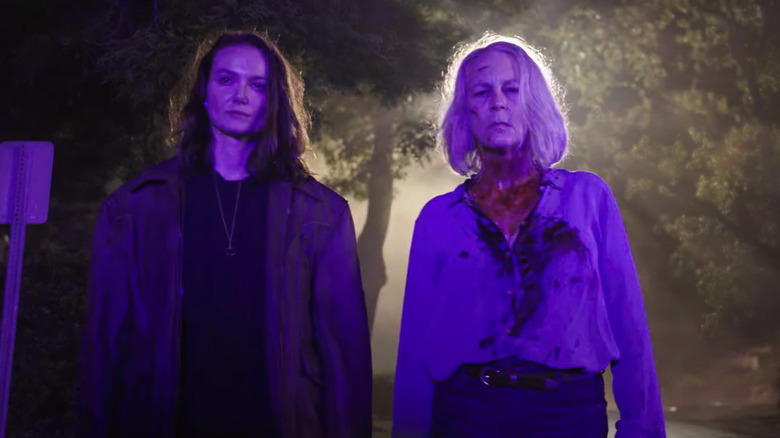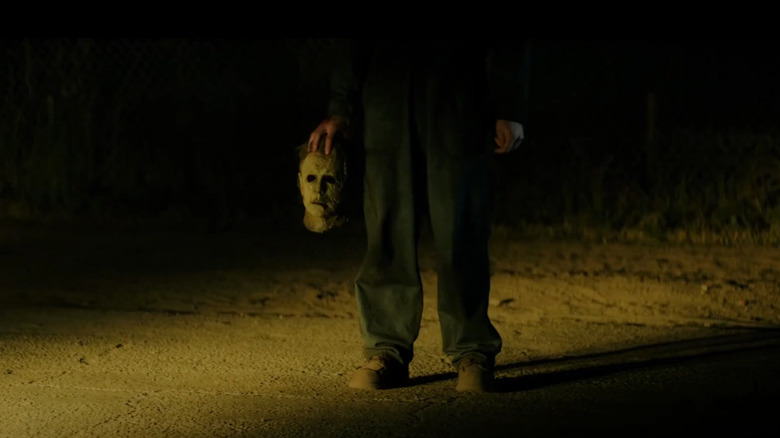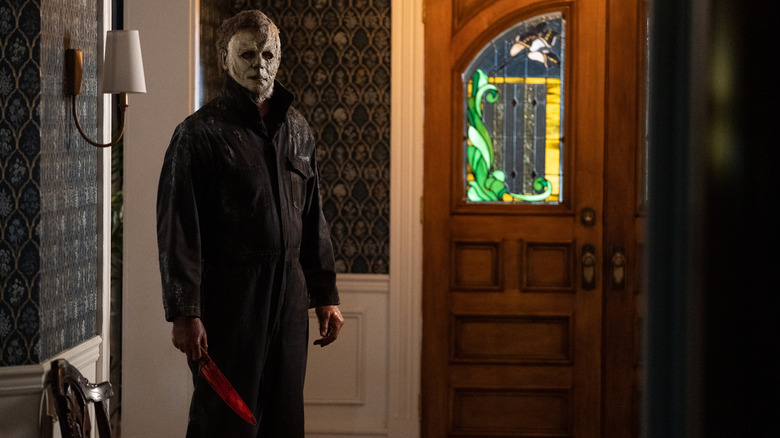The Ending Of Halloween Ends Explained
Contains spoilers for "Halloween Ends"
In 2018, the "Halloween" franchise was revitalized with a film simply titled "Halloween," which returned Jamie Lee Curtis to the forefront of the story and ignored all previous sequels with a new story and a deadly new take on Michael Myers (James Jude Courtney and Nick Castle). In 2022, the trilogy that continued with "Halloween Kills" came to an end with the appropriately titled "Halloween Ends."
As its name suggests, "Halloween Ends" is set up as one final fight between Laurie Strode (Curtis) and Michael Myers, a battle for the ages that might culminate in one or both of them finally dead after all these years. But the Laurie vs. Michael death match isn't the only major narrative going on in this film. "Halloween Ends" is packed with other characters and other concerns, all of which pay off in some way by the film's ending. So let's break it down. This is the end of "Halloween Ends," explained.
Laurie's future
When "Halloween Ends" begins, Laurie Strode is doing her best to move on with her life, writing a book about her experiences and enjoying time with her granddaughter, Allyson (Andi Matichak). Tragically, though, there's still something in Laurie that senses darkness when it starts to rise, and as soon as things get grim in Haddonfield, Illinois, again, it's clear that all of her old fear, paranoia, and readiness to fight is still somewhere inside her, waiting to come out.
By the end of the film, though, Laurie seems to have finally been able to put those things to rest, at least for the most part. She's killed her bogeyman, destroyed his body, and gone back to work on her book, even letting Allyson go so she can leave Haddonfield and start a new life. It all suggests a kind of rebirth for Haddonfield's most determined survivor, but the film leaves with a reminder that she's still at least a little haunted. Her office where she finished her memoir still contains Michael's mask, serving as a reminder to Laurie that she'll probably never stop looking over her shoulder, no matter how comfortable she gets.
Allyson's future
Allyson Nelson grew up with the paranoid specter of her grandmother, Laurie Strode, looming over her, protecting her, and loving her, so she has a certain view of the world that's been informed by that upbringing. Like Laurie, Allyson is trying to move on from the darkness of Haddonfield's past, but she's got her own inner darkness to contend with, darkness brought on by the death of her parents at Michael's hands in "Halloween" and "Halloween Kills," and darkness perhaps exacerbated by her relationship with Corey Cunningham (Rohan Campbell), the new local bogeyman who turns violent when she's not looking.
Though she's at first unwilling to believe her grandmother's claim that she's heading down a very dark path with Corey, Allyson ultimately realizes that Laurie was right to warn her, that she came very close to a brand-new serial killer hiding in plain sight. But the solution, when all the fighting is over and both Michael and Corey are dead, isn't to keep hiding or to lock herself away in Haddonfield like her grandmother once did. Instead, Allyson leaves her hometown behind to start fresh somewhere else, full of potential and hope, but also very aware of the true evils of the world, and therefore well equipped to take care of herself.
Lindsey's future
By the time of "Halloween Ends," the pool of Michael Myers survivors has shrunk considerably following the losses at the end of "Halloween Kills." Laurie's still here, as is Allyson, but one other major player who stuck around is Lindsey Wallace (Kyle Richards), Annie Brackett's babysitting charge from 1978, who managed to hide from Michael in "Kills" and survive.
Four years later, Lindsey seems to have a pretty good life. She's running a local bar, throwing festive Halloween parties for the locals, and even growing closer to Laurie and Allyson, becoming almost like a second mother to the younger woman. Then, of course, violence starts to creep back into Haddonfield, and Lindsey is swept up in more Michael Myers hysteria. She doesn't play as big a part in "Halloween Ends" and the violence that follows Laurie and Allyson, but she's still there, and it still makes an impact on her.
By the end of the film, Lindsey stands as one of only a handful of survivors of the original 1978 massacre, alongside Laurie, and she, Laurie, and Allyson see Michael Myers' final demise. As far as we can tell, it seems like she'll remain in Haddonfield to be an important part of the town's future, particularly since they need people who know how to move on from such things.
Laurie and Frank
In "Halloween Kills," we learned that Laurie Strode and Deputy Frank Hawkins (Will Patton), one of the men who arrested Michael Myers on Halloween night in 1978, once had a strong flirtation that could have turned into something more if they weren't both so damaged and reluctant. As "Halloween Ends" picks up, Frank and Laurie run into each other again in happier times, and Frank decides the time could be right to pick up where they left off. Laurie is at least somewhat reluctant to take her own advice and get back out there, but something about the final confrontation with Michael seems to shake things loose in her head.
By the end of the film, Frank stops by Laurie's house to drop off a little nod to their last flirtation, and Laurie finally settles down beside him to listen, to seemingly really take a chance on a relationship now that her bogeyman is behind her. We don't know if it'll work out for them, or if their lives are finally completely free of darkness, but at least we love both of them with a sense of hope for a shared future.
Corey's legacy
The great tragedy of "Halloween Ends" arrives in the story of Corey Cunningham, a local Haddonfield kid whose world was shattered on Halloween night in 2019 when he accidentally killed a kid he was babysitting, making him a town pariah and leaving him with a lifetime of lost dreams and guilt. But as the film shows us, Corey's guilt is eventually eclipsed by his desire to understand his own darkness and go deeper into it, something he's able to do when he crosses paths with Michael Myers in a Haddonfield sewer drain.
By the end of the film, Corey has essentially proclaimed himself the new Haddonfield bogeyman, even going so far as to steal Michael's own mask to get revenge on all the people who have wronged him and, eventually, beat a path out of town with Allyson. Laurie, of course, is too smart for that and manages to stop Corey, leading him to commit suicide.
Corey's death and the path of bodies he left behind independent of Michael form a key part of the legacy of this film because it makes us wonder just what kind of impression Corey's story will have on Haddonfield. Is he a new bogeyman or just a footnote to a bigger story? Time will tell.
If you or anyone you know is having suicidal thoughts, please call the National Suicide Prevention Lifeline by dialing 988 or by calling 1-800-273-TALK (8255).
Haddonfield's future
Haddonfield is a town that's been rocked by an absurd amount of tragedy over the course of the last 40 years, and as Laurie Strode points out early in "Halloween Ends," it's taken its toll. Even with Michael Myers gone, the town continues to suffer what feels like an ongoing series of accidents, deaths, suicide, and other tragedies. There's a darkness in Haddonfield, and Laurie sees it even when she does something as benign as going to the grocery store, where Michael's survivors and their families blame her for provoking him to more violence.
Michael's death at the end of the film, and the almost ceremonial crushing of his body at the junkyard, seems to put an end to this darkness, at least temporarily, but it leaves us with more questions about the future of Haddonfield. Will the town ever truly be free of the specter of evil? Will more people like Corey Cunningham rise up to take Michael's place? Or is Haddonfield truly able to live in a world of safety and security once again? The town's been through a lot, so even if they are on the way to recovery, that road is long.
Michael's remains
Though Michael has seemingly died in other Halloween films in the past, none of them quite matched the death he was given in "Halloween Ends." After being pinned to a table by Laurie and Allyson, Michael was bled to death through several cuts to key arteries along his body, but even then Allyson noted he was "not dead enough." So with the support of local law enforcement and much of the town, Laurie and Allyson took him to the nearby junkyard and ran his body through a grinder, reducing him to pieces. As Laurie points out at the end of the film, they also left him without a gravestone.
Still, something of Michael is still out there in the ground somewhere, and someone knows where it is. There's obviously something supernatural in Michael's physical form (more on that in a moment) that allowed him to keep pressing on beyond mortal wounds, but what happens to that power when his body is crushed beyond all repair? Will his resting place become a pilgrimage site for macabre fans? Will someone try to resurrect him? Even if nothing happens, where the rest of him ended up will be a place that lives in infamy for certain people forever.
Michael's power
In "Halloween Kills," Laurie Strode spent a little bit of time discussing and theorizing Michael Myers' seeming superhuman ability to keep getting back up, keep killing, and keep cheating death. The more he kills, she said, the more he "transcends" his physical form, meaning that if you want to stop him, you have to somehow stop the bloodshed long enough to pull him back to mortality. That's how he survives his beatdown at the end of "Halloween Kills." At least, in theory.
That would explain the dormant state he seems to be in at the beginning of "Halloween Ends," in hiding in the sewers. Later in the film, we see Laurie's speculation proven right: in one scene, when he kills Allyson's ex-boyfriend, his body actually physically begins to recover a little bit of its strength. But most of the deaths in the film actually come from Corey, not Michael, which means that by the time Michael fights Laurie, he's not as strong as he used to be, and therefore she's able to kill him at last.
But this still leaves an important question: Where does Michael's power come from, and how accessible is it to someone else? Corey thought he could gain some of it, but he still died relatively easily in the end, so how does it work for others? We might never know, and that's part of the enduring, scary mystery of Michael. He wasn't entirely human, but he wasn't entirely supernatural either.
The national spotlight
Haddonfield is a relatively small town that's been rocked over the years by some very big tragedies, and by the end of "Halloween Ends" one more major tragedy has devastated the residents on yet another Halloween night. Corey Cunningham is the second major mass murderer (that we know of) to come out of the town on the holiday in just over 40 years, and his killing spree came at the same time that the entire town banded together to destroy the body of the other mass murderer, Michael Myers.
All that, plus Laurie Strode's memoir about her experiences with Michael Myers, is bound to turn the national spotlight back on Haddonfield and the strangeness of its tragic history. Remember, in 2018's "Halloween," a pair of true-crime podcasters (Jefferson Hall and Rhian Rees) came to town with a specific focus on the Halloween 1978 tragedy and died for their trouble. What does that mean for the media personalities who might dare descend on Haddonfield this time around? Would Laurie Strode go on "Good Morning America" to tell her story? Will the town's various true-crime stops become tourist destinations? Whether Haddonfield likes it or not, their profile is about to rise again in the wake of more heinous murders, and for at least some of the residents, it won't be pretty.
The Shape
Michael Myers is dead. The ending of "Halloween Ends" makes that clear by showing us his corpse, then crushing that corpse up in a piece of junkyard machinery. It's the film's efforts to leave no potential avenue for more Michael Myers-induced terror in this version of the "Halloween" continuity and to let Laurie Strode ride off into the sunset in peace.
Except not all of Michael is really gone, at least not the version of Michael that emerged when he pulled on his mask and became "The Shape." The final shot of the film reveals that the mask, battered and burned from years of use and abuse, is still very much present, sitting on a table in Laurie's office as a dark souvenir of her victory. Laurie probably wanted to keep it on hand herself because she didn't want collectors or copycats to have a chance at getting it, but it's worth noting that she also could have destroyed the mask and didn't.
Laurie's decision to save the mask raises a number of intriguing questions, including what, if any, power the mask might hold not just over Michael, but over Laurie. Michael never wanted anyone to take it off him and would stop whatever he was doing to pull it back down if someone tried. That, plus his apparent transcendent abilities while wearing the mask, would suggest that it's more than just a face covering. Maybe Laurie's about to find out how much more.
The future of the franchise
Beyond the narrative of the film itself, "Halloween Ends" also represents an interesting benchmark in the history of the "Halloween" franchise. It's not the first film that attempted to kill off Michael Myers. "Halloween II" blew him and Dr. Sam Loomis (Donald Pleasence) to smithereens in 1981, and they both returned in the fourth film. "Halloween H20: 20 Years Later" tried again in 1998, when Laurie decapitated him with a fire ax, which was retconned one movie later. Michael's deaths didn't seem as final and definitive in those earlier films as the one in "Halloween Ends."
And yet, people still clearly have an appetite for these films, whether Michael's dead or not, so where does that leave future installments in the series? Jamie Lee Curtis seems well and truly done with Laurie Strode (per the Los Angeles Times), so there's certainly a possibility that in a few years, another reboot could emerge that allows Michael to kill again with a different group of characters. "Halloween Ends" producer Jason Blum has left the door open for that, as has original creator John Carpenter, who noted that as long as the films make money, someone will want to make more of them. It's notable, though, that Blumhouse no longer has the rights to the franchise, having promised to deliver only three films (per ComicBook).
It's also possible that "Halloween" could live on without Michael. The Michael-less "Halloween III: Season of the Witch" has developed a massive cult following in the years since its release, prompting some fans to wonder if new films could revisit that story or that timeline. There are lots of possibilities, but one thing that seems clear is that, no matter how long it takes, the "Halloween" franchise, like Michael himself, will always be back in some form.
